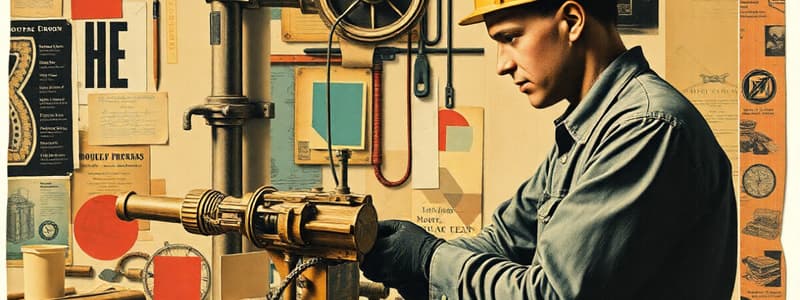Podcast
Questions and Answers
What is the primary responsibility of a fitter?
What is the primary responsibility of a fitter?
- Designing new machinery models
- Assembling, installing, and repairing mechanical components (correct)
- Conducting market research for equipment sales
- Managing construction sites
Which type of fitter specializes in piping systems?
Which type of fitter specializes in piping systems?
- Mechanical Fitter
- Pipe Fitter (correct)
- Electrical Fitter
- Structural Fitter
What skill is essential for a fitter when working with technical documents?
What skill is essential for a fitter when working with technical documents?
- Ability to read and interpret blueprints (correct)
- Sales and marketing knowledge
- Public speaking skills
- Artistic design skills
What is a common working environment for fitters?
What is a common working environment for fitters?
What is one possible career advancement opportunity for a fitter?
What is one possible career advancement opportunity for a fitter?
Flashcards are hidden until you start studying
Study Notes
Definition
- A fitter is a tradesperson responsible for assembling, installing, and repairing mechanical components, equipment, or systems.
Key Responsibilities
- Read and interpret technical drawings and schematics.
- Measure and cut materials accurately.
- Assemble mechanical components using tools and equipment.
- Install machinery and ensure proper alignment and operation.
- Conduct routine maintenance and repairs.
- Troubleshoot mechanical issues and offer solutions.
Types of Fitters
-
Pipe Fitter
- Specializes in pipes, fittings, and tubing in construction or industrial settings.
- Responsible for installing and maintaining piping systems.
-
Mechanical Fitter
- Focused on machinery assembly and maintenance.
- Works with engines, pumps, and other mechanical equipment.
-
Structural Fitter
- Involved in fitting and assembling structural components like beams and trusses.
- Often works in construction and fabrication.
-
Sheet Metal Fitter
- Specializes in fabricating and installing sheet metal products.
- Works with HVAC systems, ductwork, and piping.
Skills Required
- Proficiency in using hand and power tools.
- Strong mathematical and mechanical aptitude.
- Problem-solving skills for troubleshooting.
- Attention to detail for quality work.
- Ability to work with blueprints and technical documents.
Working Environment
- Fitters may work in various settings, including factories, construction sites, and maintenance departments.
- Safety equipment and practices are crucial due to the risk of working with heavy machinery and tools.
Qualifications
- Completed apprenticeship or vocational training in fitting or a related field.
- Certification or licensure may be required depending on the specific area of fitting.
Career Path
- Fitters can advance to supervisory or managerial roles, or specialize in specific systems (e.g., HVAC, plumbing).
- Opportunities also exist for self-employment or starting a business in fitting services.
Fitter Roles and Responsibilities
- Fitters are skilled tradespeople who assemble, install, and repair mechanical components, equipment, or systems.
- They read and interpret technical drawings and schematics to understand the project.
- Measuring and cutting materials accurately is essential for precise assembly.
- Fitters use various tools and equipment to assemble mechanical components.
- Installing machinery and ensuring proper alignment and operation is a crucial aspect of their job.
- Routine maintenance and repairs are part of their responsibilities to keep equipment functioning optimally.
- Troubleshooting mechanical issues and offering solutions requires problem-solving skills and technical knowledge.
Types of Fitters
- Pipe Fitters specialize in pipes, fittings, and tubing, often working in construction or industrial settings. They install and maintain piping systems for various purposes like water, gas, or oil.
- Mechanical Fitters focus on machinery assembly and maintenance, working with engines, pumps, and other mechanical equipment. They ensure the efficient operation of industrial machinery.
- Structural Fitters specialize in fitting and assembling structural components like beams and trusses, often working in construction and fabrication. They ensure the stability and strength of buildings and structures.
- Sheet Metal Fitters fabricate and install sheet metal products, commonly working with HVAC systems, ductwork, and piping. They ensure proper ventilation, air conditioning, and heating systems.
Skills Required
- Proficiency in using hand and power tools is essential for all types of fitters.
- A strong mathematical and mechanical aptitude is needed to understand measurements, calculations, and the functioning of mechanical systems.
- Problem-solving skills allow fitters to troubleshoot and fix issues effectively.
- Attention to detail is crucial to ensure quality work and prevent safety hazards.
- The ability to work with blueprints and technical documents is essential for understanding project requirements and specifications.
Working Environment
- Fitters work in various settings, including factories, construction sites, and maintenance departments.
- Their work environment can be demanding, often requiring physical exertion and working in confined spaces.
- Safety equipment and practices are essential due to the risk of working with heavy machinery and tools.
Qualifications and Career Path
- A completed apprenticeship or vocational training in fitting or a related field is typically required.
- Depending on the area of fitting, certifications or licenses may be necessary.
- Fitters can advance to supervisory or managerial roles or specialize in specific systems like HVAC or plumbing.
- Self-employment and starting a business in fitting services also present career opportunities.
Studying That Suits You
Use AI to generate personalized quizzes and flashcards to suit your learning preferences.




